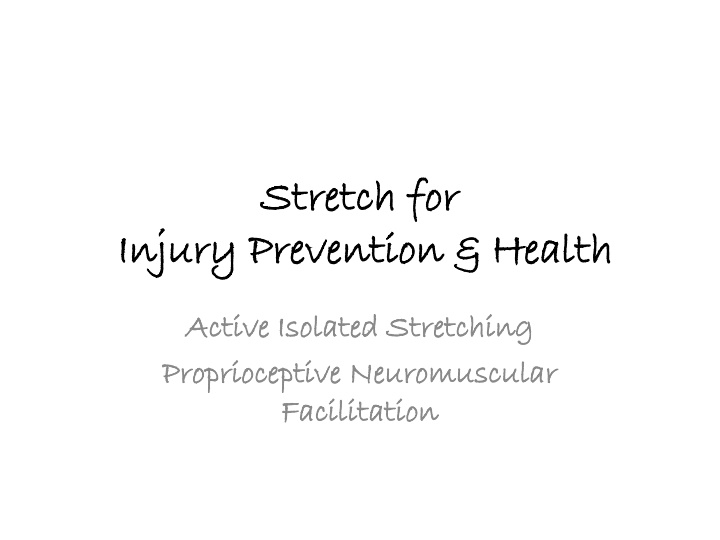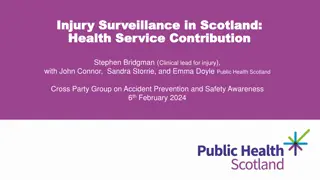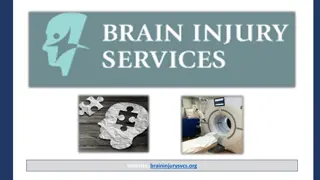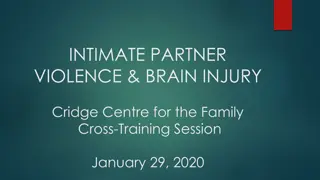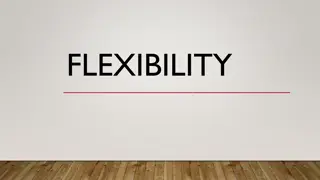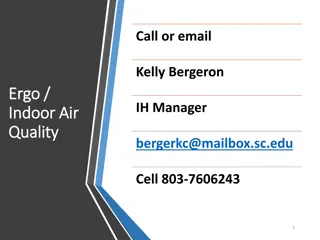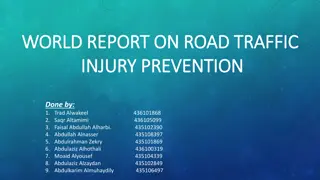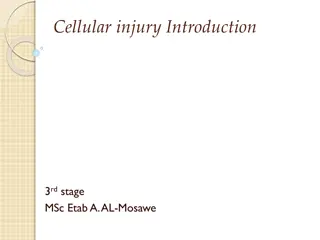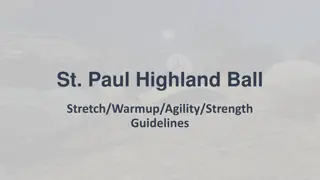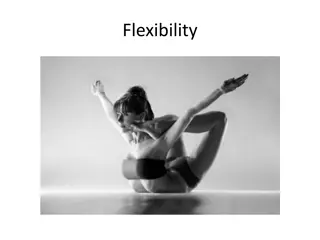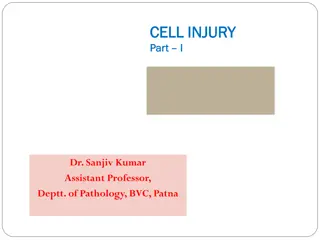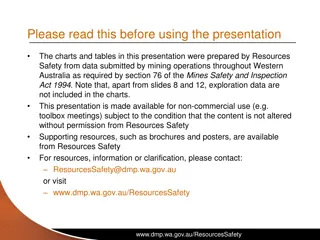Comprehensive Stretching Techniques for Injury Prevention & Health
Learn about different types of stretching techniques including Active Isolated Stretching, Proprioceptive Neuromuscular Facilitation, muscle contractions, automatic stretch reflexes, and the importance of understanding reciprocal innervations. Discover how these methods contribute to injury prevention and improving overall health.
Download Presentation

Please find below an Image/Link to download the presentation.
The content on the website is provided AS IS for your information and personal use only. It may not be sold, licensed, or shared on other websites without obtaining consent from the author.If you encounter any issues during the download, it is possible that the publisher has removed the file from their server.
You are allowed to download the files provided on this website for personal or commercial use, subject to the condition that they are used lawfully. All files are the property of their respective owners.
The content on the website is provided AS IS for your information and personal use only. It may not be sold, licensed, or shared on other websites without obtaining consent from the author.
E N D
Presentation Transcript
Stretch for Stretch for Injury Prevention & Health Injury Prevention & Health Active Isolated Stretching Active Isolated Stretching Proprioceptive Proprioceptive Neuromuscular Neuromuscular Facilitation Facilitation
References: References: The Wharton Stretch The Wharton Stretch Book . Active Isolated Book . Active Isolated Stretching Stretching Jim and Phil Wharton ISBN: 0812926234 Facilitated Stretching Facilitated Stretching Robert E. Mc Atee & Jeff Charland ISBN: 0736062483 Anatomy Information http://www.getbodysma rt.com Tortora Human Anatomy
Presenters Presenters Sara Sara Toogood BS in Exercise Technology Licensed Massage Bodywork Therapist Stretching photos: http://www.bodyworkconnect ions.com/index.php?option=c om_rsgallery2&Itemid=62& catid=8 Jackie Miller Jackie Miller Britfit Personal Training and Coaching ACE Certified Personal Trainer USA Triathlon Coach, Expert Level II Certified Functional Movement Screen Specialist Toogood Office: 919-567-5371 Cell: 919-602-3868 www.bodyworkconnections.com Fax/office: 919-552-2817 Cell: 919-818-7096 www.Britfit.com
Muscle Contractions Muscles can elongate up to 1.6 times their length. Isometric: Isometric: A muscular Contraction that has NO movement Isotonic Isotonic: A muscular contraction that causes movement. Concentric: muscle fibers shorten in the contraction Eccentric: muscles fibers lengthen by an outside force. This is also commonly referred to as the Negative
Automatic Stretch Reflexes Reciprocal Innervations Reciprocal Innervations Aka: Reciprocal inhibition This is when the muscle tells the brain I want to move or contract and the brain then sends a message to the opposing muscle to relax so that the muscle wanting to contract can do so without restraint. (this is the basis of PNF theory) Myotatic Myotatic Stretch Reflex Stretch Reflex This is the reflex reaction when a muscle is in danger of over stretching. The muscle sends a message to the brain that it is in danger of OVERSTRETCHING and the brain then sends a message back that inhibits the stretch. This stretch inhibition thereby, prevents a muscular injury. This generally kicks in at three seconds. (this is the basic theory behind Active Isolated Stretching)
Types of Stretching Types of Stretching Passive Stretching PS is usually done TO the stretcher . A well trained partner (PT) is actively moving the passive non-assistive stretcher. This is used when Active Stretching causes pain. It is absolutely ESSENTIAL the absolutely ESSENTIAL the partner is sensitive to the partner is sensitive to the stretcher so as NOT to cause stretcher so as NOT to cause further injury. further injury. Active Stretching: AS is when the stretcher is doing the stretching. . It is
Types of Stretches Continued Types of Stretches Continued Ballistic Stretching Ballistic Stretching BS is rapid bouncing movements. Ballistic stretching is not encouraged due to the myotatic reflex which tends to leave the muscle fibers shorter rather than longer . Thereby, more prone to injury, either micro tearing of muscle tissue or more serious rupture of tendonus tissue. Active Assisted Stretching Active Assisted Stretching AAS is when active movement by the stretcher is aided by a partner. Generally adding passive stretch by the partner at the end of the stretcher doing Active Stretching or when the stretching is having some resistance to motion; the partner is able to gently push the stretcher beyond his active point and to a new deeper stretch.
Types of Stretches Continued Types of Stretches Continued Dynamic Stretching: Dynamic Stretching: DS is also referred to as Dynamic Range of Motion (DROM). Moving a limb through full ROM slowly and controlled and with subsequent ROM the speed of the movement increases with greater flexibility. . Static Stretching: Static Stretching: Bob Anderson made Static Stretching popular. SS is when the muscle is lenghtened slowly and held in a comfortable range for 15 30 seconds; until the stretch sensation subsides and then the stretch is deepened, gently moving more into the stretch.
Active Isolated Stretching Active Isolated Stretching Active Isolated stretching was developed by Aaron Mattes, a Physical Therapist. This form of stretching uses Reciprocal Inhibition with Active Movement. AIS does not use isometric contractions. Isolate the muscles you want to stretch. Go through basic ROM Go to the end of the stretch. Hold for 2 seconds Then return to the original position Repeat 8 10 times.
PNF Stretching PNF Stretching Proprioceptive Proprioceptive Neuromuscular Facilitation Neuromuscular Facilitation Again, Many Physical Therapists contributed to the development of PNF stretching. PT s discovered that our bodies work on a spiral/diagonal movement which sends stimulus to the brain. Proprioceptors within the muscles transmitting Neurologically. This theory has since been scaled into a form of effective stretching to gain flexibility.
PNF Continued PNF Continued C. R. A. C . C. R. A. C . C Contract the target muscle. Aka: the Agonist. Contract the muscle using 50% or less strength for 6 seconds. 6 seconds. R Relax: Take a deep oxygen filled breath & exhale. A C: A C: Contract the Antagonist muscle; the opposing muscle, thereby gaining more stretching in the Agonist, your target muscle. (RI) 50% or less of your
Major Muscle Groups Major Muscle Groups
10 Basic Stretches 10 Basic Stretches 1. Quads Rectus Femoris Vastus Lateralis Vastus Intermedius Vastus Medius 2. Iliopsoas Iliacus Psoas Major
10 Basic Stretches Continued 10 Basic Stretches Continued 3. Hamstrings Semimembranosus Semitendinosus Biceps Femoris 4. Calf Gastrocnemius Soleus
10 Basic Stretches Continued 10 Basic Stretches Continued 5. Chest Upper Back Rhomboids 7. Traps Trapezius Upper Levator Scapulae 8. Neck Rotation (Sterno Cleido Mastoid) 9. Neck Lateral Flexion (Scalenes/splenius cervicis) 10. Back Erector Spinea (Paraspinals: Longissimus, Spinalis, Iliocoastalis) Pectoralis Major 6.
